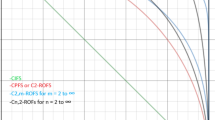Abstract
An algorithm of vague fault-tree analysis is proposed in this paper to calculate fault interval of system components from integrating expert's knowledge and experience in terms of providing the possibility of failure of bottom events. We also modify Tanaka et al's definition and extend the new usage on vague fault-tree analysis in terms of finding most important basic system component for managerial decision-making. In numerical verification, the fault of automatic gun is presented as a numerical example. For advanced experiment, a fault tree for the reactor protective system is adopted as simulation example and we compare the results with other methods. This paper also develops vague fault tree decision support systems (VFTDSS) to generate fault-tree, fault-tree nodes, then directly compute the vague fault-tree interval, traditional reliability, and vague reliability interval.
Similar content being viewed by others
References
Alexandre E, Sylviane G, Jacky M (2000) Fuzzy reasoning in co-operative supervision systems. Control Eng Pract 8:389–407
Cai KY (1996) System failure and fuzzy methodology: an introductory overview. Fuzzy Sets Syst 83:113–133
Chen SM (1995) Measures of similarity between vague sets. Fuzzy Sets Syst 74:217–223
Chen SM (2003) Analyzing fuzzy system reliability using vague sets theory. Int J Appl Sci Eng 1:82–88
Cheng CH, Mon DL (1993) Fuzzy system reliability analysis by confidence interval. Fuzzy Sets Syst 56:29–35
Eisenack K, Kropp J (2001) Assessment of management options in marine fisheries by qualitative modeling techniques. Mar Pollut Bull 43(7–12): 215–224
Furuta H, Shiraishi N (1984) Fuzzy importance in fault tree analysis. Fuzzy Sets Syst 12:205–213
Gau WL, Buehrer DJ (1993) Vague sets. IEEE Trans Syst Man Cybern 23:610–614
Goul M, Shane B, Tonge F (1986) Knowledge-based decision support system in strategic planning decision: an empirical Study. J Manage Inf Syst 2:70–84
Huang HZ, Tong X, Zuo MJ (2004) Posbist fault tree analysis of coherent systems. Reliability Eng Syst Safety 84:141–148
Kales P (1998) Reliability: for technology, engineering, and management. Prentice-Hall, Englewood Cliffs
Kwok RCW, Ma J, Zhou DN (2002) Improving group decision making: a fuzzy GSS approach. IEEE Trans Syst Man Cybern SMC-32:54–63
Lee F (1998) Fuzzy information processing system. Peking University Press, pp 118–132
Lee C, Lu TC, Lee NP, Chung UK (1999) The study of strategy on new equipment maintenance. Fuzzy Sets Math 13:37–44
Li SL (2000) The development of a hybrid intelligent system for developing marketing strategy. Decis Support Syst 27:395–409
Liang GS, Wang MJJ (1993) Fuzzy fault tree analysis using failure possibility. Microelectron Reliability 33:587–597
Liao SH (2001) A knowledge-based architecture for implementing military geographical intelligence system on Intranet. Expert Syst Appl 20:313–324
Lin CT, Wang MJ (1997) Hybrid fault tree analysis using fuzzy sets. Reliability Eng Syst Saf 58:205–213
Love E, Mats D, Magnus B (1997) Imposing security constraints on agent-based decision support. Decis Support Syst 20:3–15
Mikhailov L, Singh MG (2003) Fuzzy analytic network process and its application to the development of decision support systems. IEEE Trans Syst Man Cybern SMC-33:33–41
Mon DL, Cheng CH (1994) Fuzzy system reliability analysis for components with different membership functions. Fuzzy Sets Syst 64:145–157
Mon DL, Cheng CH (1993) Fuzzy system reliability analysis by interval of confidence. Fuzzy Sets Syst 56:29–35
Muller K, Sebastian HJ (1997) Intelligent systems for engineering design and configuration problems. Eur J Operational Res 100:315–326
Scott MS (1971) Management decision systems: computer support for decision making. Harvard University Press, Cambridge
Singer D (1990) A fuzzy set approach to fault tree and reliability analysis. Fuzzy Sets Syst 34:145–155
Suresh PV, Babar AK, Raj VV (1996) Uncertainty in fault tree analysis: a fuzzy approach. Fuzzy Sets Syst 83:135–141
Tanaka H, Fan LT, Lai FS, Toguchi K (1983) Fault-tree analysis by fuzzy probability. IEEE Trans Reliability 32:150–163
Tam CM, Thomas KL, Gerald CW, Ivan WH (2002) Non-structural fuzzy decision support system for evaluation of construction safety management system. Int J Project Manage 20:303–313
Toshiyuki Y (1997) On a support system for human decision making by the combination of fuzzy reasoning and fuzzy structural modeling. Fuzzy Sets Syst 87:257–263
Walley P (1991) Statistical reasoning with imprecise probabilities. Chapman Hall, London
Walley P (1997) Statistical inferences based on second-order possibility distribution. Int J Gen Syst 26:337–383
Zadeh LA (1965) Fuzzy sets. Inf Control 8:338–353
Borland C++ Builder, Borland Software Corporation
Author information
Authors and Affiliations
Corresponding author
Rights and permissions
About this article
Cite this article
Chang, JR., Chang, KH., Liao, SH. et al. The reliability of general vague fault-tree analysis on weapon systems fault diagnosis. Soft Comput 10, 531–542 (2006). https://doi.org/10.1007/s00500-005-0483-y
Published:
Issue Date:
DOI: https://doi.org/10.1007/s00500-005-0483-y




